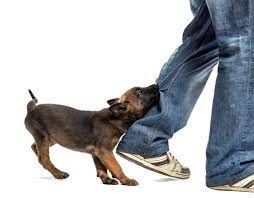 ∙ Medication is an often-underutilized tool that can greatly help with managing aggression in dogs, according to veterinary behaviorist Dr. Karen Overall.“I’ve never not treated aggression with medication, because aggression is fundamentally an anxiety disorder,” said Dr. Overall, a professor of behavioral medicine at the University of Prince Edward Island Atlantic Veterinary College. “We change how the dog thinks by using selective serotonin reuptake inhibitors and tricyclic antidepressants that work by remodeling neurons and make acquiring new behaviors easier,” she explained.
∙ Medication is an often-underutilized tool that can greatly help with managing aggression in dogs, according to veterinary behaviorist Dr. Karen Overall.“I’ve never not treated aggression with medication, because aggression is fundamentally an anxiety disorder,” said Dr. Overall, a professor of behavioral medicine at the University of Prince Edward Island Atlantic Veterinary College. “We change how the dog thinks by using selective serotonin reuptake inhibitors and tricyclic antidepressants that work by remodeling neurons and make acquiring new behaviors easier,” she explained.
Approximately 4.5 million people are bitten by dogs in the United States each year, and more than 800,000 dog-bite victims require medical attention, according to the Centers for Disease Control and Prevention.
Dogs with unaddressed behavioral problems not only threaten public health but are more likely to be surrendered and euthanized. To the untrained eye, a snarling or barking dog may be seen as overly threatening or aggressive when in fact the dog is behaving normally in the particular situation. As Dr. Overall explained, agonistic behaviors are complex social interactions that manifest as displays of dominance, submission, and reconciliation.

These behaviors can appear aggressive and include biting but are ultimately a normal part a dog’s behavioral repertoire. “Maybe there are communication errors or uncertainty, or maybe a dog was behaving aggressively but reconsidered after obtaining more information from one of the participants,” Dr. Overall said. “Implicit here is one party makes a statement, the other party responds, and they go from there.”
Determining whether aggressive behaviors are normal or inappropriate is the context in which they occur. One example of normal aggression is a dog snarling when another dog in the household, after eating its own meal, tries to eat the meal that the snarling dog is eating. In contrast, abnormal or pathological aggression occurs out of context or over an extended period of time. It also manifests as an extreme overreaction given the situation.

“Inherent in these comparisons is that the response to a triggering circumstance is episodic in fear and fear aggression, but chronic in anxiety since the initial trigger is the underlying state itself,” Dr. Overall said.
Fearful dogs choose to withdraw. They want distance between themselves and whatever is scaring them. They’ll back off and lower every part of their body. Anxious dogs, on the other hand, won’t retreat but must scan and monitor the situation. Their anxiety prevents them from interrupting what is happening in a given context.
Key to treating aggression is identifying the context and causes for the behavior. Before a dog becomes aggressive, there is first an arousal phase in which the dog reacts to negative stimuli. The arousal phase can occur quickly and is easily missed, Dr. Overall said.
“You don’t realize how fast it happens,” she said. “The window closes so quickly, maybe a tenth of a second. People say they tried to redirect the dog when it becomes aggressive, but it’s too late at that point.”
Clients can participate in their dog’s treatment by using a smartphone to make a recording of their pet that a veterinarian can review. “We want videos. We want to see what they do in their home environment. All the information is right there,” Dr. Overall said.
Four drug compounds are currently approved by the Food and Drug Administration to treat some forms of canine anxiety: clomipramine, fluoxetine, dexmedetomidine, and imepitoin.
Dr. Overall considers treatment with drugs as a complement to behavioral modification, which rewards positive behaviors and ignores unwanted behaviors.
National Dog Bite Prevention Week, sponsored by the AVMA, is being held this year from April 10-16.
∙ Do’s and Don’ts for Communicating with Your Cat
From body language to training tips, here’s how to build better bonds with feline pals.
by Brittany Edelmann
Do: Watch Their Body Language
If your cat approaches you with his or her tail up, like a question mark, this can mean it is “probably going to be friendly, or at least comfortable with the interaction that is going on so far,” Lilly explains. But, if there is slow movement and low-to-the-ground posture, pretending as though the cat “doesn’t exist” to increase comfortability prior to interaction can help, Lilly says. Likewise, if the ears are pinned back, “then they’re not a happy cat,” says Marina Jaworsky, associate veterinary at Green Tree Animal Hospital in Libertyville, Illinois.
Don’t: Reprimand Your Cat
If you pet your cats or try to get them to come near you and they become scared or uncomfortable, they may decide they’ve had enough, “and they might even nip at you,” Jokela says. Even if you think your pet is being mean — what cat owner hasn’t? — don’t act out against them. Yelling, scolding, or even spraying water on them will “definitely break the bond,” Jokela says.
Don’t: Use Laser Pointers
Playing with your cat can help you form a stronger bond, Jokela says. But laser pointers, which many cats seem to love, may not be the best toy. The caveat? When cats are constantly chasing something that they will never catch, it can create or worsen OCD and obsessive tendencies, where your kitty is “always looking out for this thing because they don’t get the satisfaction of catching it at the end,” Castro says. Left with nothing to nab, this can leave cats stressed and contribute to health and behavior issues. One 2021 research study showed increased reports of abnormal repetitive behaviors the more that laser light pointers were used.
Every cat is different. Understanding what they like and don’t like, keeping stress to a minimum and making them as comfortable as possible is key to a better relationship. What’s most important? “Respecting their boundaries and interacting in a way that they want to interact, versus the way you may want to interact, can be beneficial for your relationship,” Castro says.
